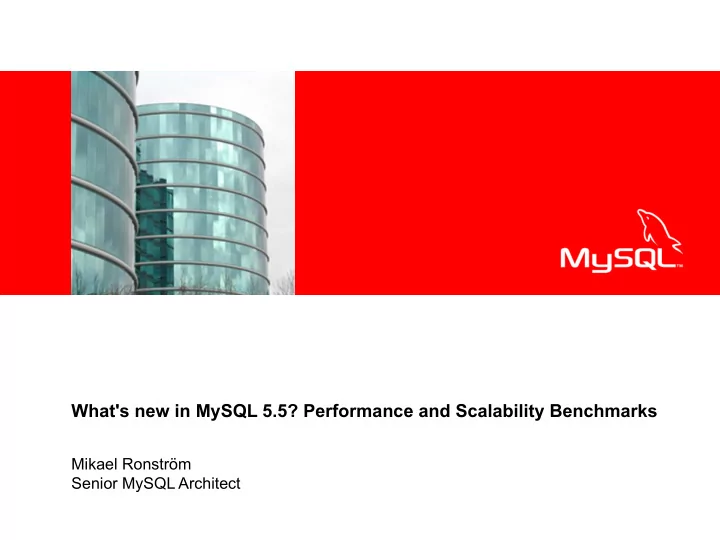

<Insert Picture Here> What's new in MySQL 5.5? Performance and Scalability Benchmarks Mikael Ronström Senior MySQL Architect
The preceding is intended to outline our general product direction. It is intended for information purposes only, and may not be incorporated into any contract. It is not a commitment to deliver any material, code, or functionality, and should not be relied upon in making purchasing decisions. The development, release, and timing of any features or functionality described for Oracle’s products remains at the sole discretion of Oracle.
Outline of talk • Analysis of MySQL Server and InnoDB changes • Analysis of important InnoDB configuration parameters • Analysis of Partitioning as Performance Booster • Impact of Powersave mode on Benchmarks • Scalability Analysis of MySQL 5.5.4-m3 • Analysis of behaviour of MySQL 5.5.4-m3
Log_sys mutex Improvement • Zero impact on read-only benchmarks • Improves performance by 5% when added to MySQL 5.5.3-m3 baseline on 16-core MySQL Server • SHOW ENGINE INNODB MUTEX shows that log_sys mutex have decreased contention • The new log_flush_order mutex have very little contention • Combined with other patches the impact is smaller most likely
Split Buffer Pool into multiple instances • Sysbench RW on 16-cores improves 10% • Works very well together with Split Rollback Segment Mutex • Improves Read Only performance as well • Very large improvement on 32-core/threaded
Split out Buffer Pool Page Hash into array of mutexes • About 10% improvement of Sysbench RW on 16-core • No improvement or even decrease of Read Only performance • Very good scalability on 32-core/thread
Split-out Page Hash vs. Multiple Buffer Pool instances • Multiple Buffer Pool instances better Read Only performance • Multiple Buffer Pool instances can combined with split-out page hash later if it makes sense • Multiple Buffer Pool instances worked better on 32- core servers
Analysis of new InnoDB Buffer Pool instances • –innodb-buffer-pool-instances=x
Split-out Flush List from Buffer Pool mutex • No impact of Read Only performance • A few percent improvement of ReadWrite workloads
Split Rollback Segment into 128 Rollback Segments • Combined with multiple buffer pool instances works very well and gives dramatic improvements on 32- core servers
Split Purge Thread into separate thread from Master Thread • Required to get stable performance • Mean performance slightly impacted positively or negatively • Max performance decreases • Min performance significantly increases • Higher mean performance can often happen due to History Length continously increasing, will eventually lead to out of disk space
dbSTRESS: Read+Write & Purge Thread
Remove LOCK_alarm mutex • Standalone improved 2%, improved both Read Only and Read Write
Improvement of LOCK_open, step 1, remove hash calculation from LOCK_open • Improved performance of ReadOnly/ReadWrite a few percent
Remove many uses of LOCK_thread_count • Standalone no improvement • Combined with LOCK_open improvement and LOCK_alarm it improved ReadOnly/ReadWrite a few percent
Introduction of MDL locking framework • Removed drop at high number threads due to change of how LOCK_open gets TABLE objects • Improved performance a few percent
Improvement of LOCK_open based on MDL framework • Improved performance a few percent
Analysis of InnoDB Log File Size • 128MB => 1024MB: 6000 TPS => 8000 TPS
Analysis of InnoDB Log Buffer Memory • No specific benchmarks executed • Large buffer means less contention on log_sys mutex
Analysis of use of InnoDB Adaptive Hash • For Sysbench RO/RW on 16-cores improved performance by about 3-4% to not activate it
Analysis of Partitioning as Performance Booster • Improves performance by splitting the InnoDB Index mutex
dbSTRESS: Using Partitions
Impact of Powersave mode on Benchmarks/Applications • /etc/init.d/cpuspeed on Linux • Performance can drop significantly at low number of active connections (@16 threads performance drops to about half) • Performance at 32 threads drops about 10% • Performance at 64+ threads same
OLTP RO
OLTP RW
OLTP RW Scalability (4->16 cores) 7000 6000 5000 4000 MySQL 5.1 MySQL 5.5.3-m3 MySQL 5.5.4-m3 3000 2000 1000 0 4-core 8-core 12-core 16-core
OLTP RO Scalability (4->16 cores) 12000 10000 8000 MySQL 5.1 6000 MySQL 5.5.3-m3 MySQL 5.5.4-m3 4000 2000 0 4-core 8-core 12-core 16-core
OLTP RW Write Intensive 4000 3500 3000 2500 MySQL 5.1 2000 MySQL 5.5.3-m3 MySQL 5.5.4-m3 1500 1000 500 0 4-core 8-core 12-core 16-core
dbStress scalability 1 thread per core 12->32 cores 35000 30000 25000 20000 RO RW 15000 10000 5000 0 12-cores 16-cores 24-cores 32-cores
dbStress scalability 2 threads per core 30000 25000 20000 RO 15000 RW RW10 10000 5000 0 8-core 16-core 32-core
dbSTRESS: Read-Only
dbSTRESS: Read-Only Hot Mutexes • kernel_mutex + B-tree + LOCK_open
dbSTRESS: Read+Write @16cores
dbSTRESS: Read+Write Hot Contentions • Index mutex + kernel_mutex
dbSTRESS: Read+Write Long 32sessons Test
dbSTRESS: Using Partitions
dbSTRESS: Partitions + Purge Thread
dbSTRESS: Read+Write & InnoDB Concurrency • innodb_thread_concurrency= 0 / 32
Analysis of remaining scalability hogs • Previously have been mainly hogged by global mutexes • Now (especially for Read-only) also other effects becomes part of the picture such as False Cacheline sharing
Thank you for your attention Questions?
Recommend
More recommend